Subscribe to ‘Words Of Hope’
Get our emails direct to your Inbox with updates about all our campaigns, trips and events.
“In the past few years, it’s been my great pleasure to be part of two large groups that have visited Nicaragua. We have gone to see the inspiring work CEPAD is doing in these communities that are facing the effects of climate change.” Peter Bone shares his experiences of travelling to Nicaragua with Amos Trust.
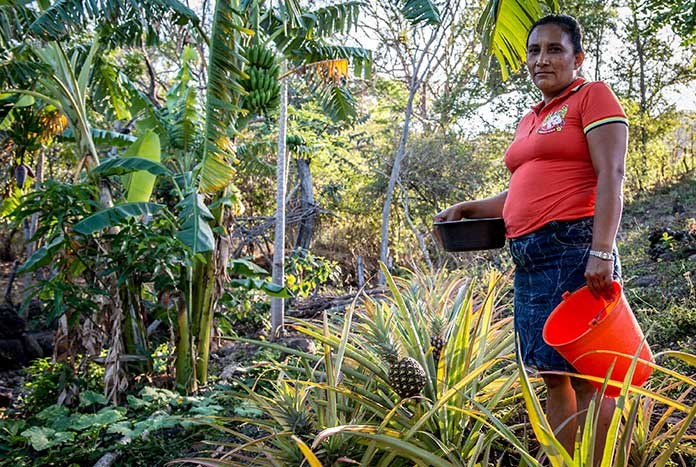
Introduction
For the May edition of First Of The Month, we’re heading to Nicaragua, which we often describe at Amos as ‘the place where we learn.’ It’s a country that is particularly vulnerable to changing weather patterns and is the fourth most at-risk nation in the world due to changing climates.
Amos Trust supports seven rural communities in Teustepe in Nicaragua through our partner CEPAD who use an inspiring model of empowerment with each community to help them address the impact of climate change and the causes of extreme poverty.
Our friend Peter Bone first travelled to Nicaragua with Amos back in 2000. Here, he writes about the people, the art, the politics and the communities in which CEPAD works and who we support through your generous donations.
Our current appeal for Nicaragua is called There Is No Planet B — any support you can give would be very welcome. Thank you.
The Mandarins of Nicaragua
“It was the mandarins that got me.” — February 2000
— — — — — — — —
The end of the first day on my first visit to Nicaragua. The Amos group was tightly squeezed into our van. We were jet lagged and exhausted after a long day of activities in Managua and Granada. We thought we were on our way home, but we’d just learned that we would drop in on a church service (the second of the day).
We stumbled, bewildered, out into the dark. Half an hour later we were all buzzing. In this tiny rural church we’d been given the warmest of welcomes by locals, and their pastor Gilberto Aguirre. By the end of the service we’d taken a communion of Oreo biscuits and Fanta and had been greeted by name by every member of the church. We climbed back into the van with the armfuls of mandarins they had pressed upon us.
Sandinista
— — — — — — — —
My visit to Nicaragua had been a long time coming. My friend David Pritchard returned from the Greenbelt Festival in the mid 1980s clutching Bruce Cockburn’s Stealing Fire album. He told me about the revolutionary government made up of priests and poets, how they’d overthrown Somoza, a corrupt US-backed dictator, and how the Contras were sowing death and destruction from across the Honduran border.
I suspect it was the David vs Goliath narrative that piqued my initial interest but the more I learned about Nicaragua, the more I fell in love with it. Before long I was a signed up member of the Nicaragua Solidarity Campaign with a poster of Sandino on my wall.
The first Nicaraguan I met was the Mayor of Bluefields (on the Atlantic Cost), whom I heard talk while I was working at Christian Aid. I asked him if he was a Sandinista, and he just laughed. When I first heard Gustavo Parajon, the founder of CEPAD, speak at Greenbelt in 1987, he wasn’t dwelling on the war, but talking about bringing reconciliation. The more I learned, the more complex it seemed to be. In 1987, Nicaragua was having a moment. A group of Scottish Christians organised Cabaret Nicaragua at Greenbelt, where Gustavo spoke, Bruce Cockburn sang, and Bono snuck in to watch.
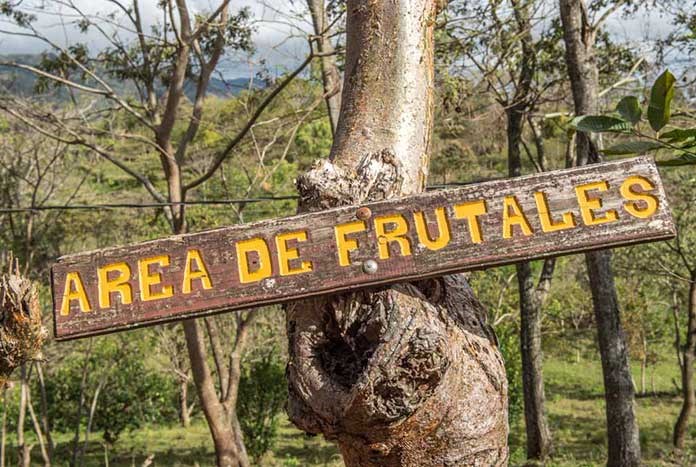
‘Area De Frutales’ — a sign on the edge of a fruit field in Teustepe in rural Nicaragua
— — — — — — — —
CEPAD is Amos’ partner in Nicaragua. The story of its birth says much about Nicaragua, CEPAD and Gustavo. This was in 1972, after a horrific earthquake in the capital, Managua. Planeloads of aid had come in, but it hadn’t reached the people who needed it.
Gustavo challenged President Somoza directly on it and then somehow ended up borrowing the government’s official radio station to send a message out to pastors across the country to come to Managua to help the people. The informal group of pastors who came ended up forming CEPAD.
The government’s wilful withholding of aid proved to be the tipping point that led to insurrection, and the eventual overthrow of the government by the Sandinistas in 1979. Their (initial) spell of power only lasted until 1990. What struck me when I read about those years in power was the creativity with which the Sandinistas looked to solve the country’s problems. They cut the illiteracy rates in half by inviting people from the cities who could read out to the countryside to teach. They broke up the huge tracts of land owned by the Somoza family and their cronies and shared it out, so everybody had their own land to work on.
CEPAD
— — — — — — — —
CEPAD works in a very similar way and draws from the same well of independence and creativity — it seems to be a national trait. Within a few months of forming, their emergency relief work in the capital had come to an end. But they decided to continue to work, and moved their focus to the much poorer rural areas, where it has continued ever since.
A key memory of that trip in 2000 was our final day. We spent a long morning visiting micro businesses that CEPAD was funding. I remember a multi-generational family whose tiny house was filled with bottles that they had collected from the rubbish dump. Each room, and family member, was dedicated to one of the many stages of recycling. I was struck not only by their ingenuity, but by that of CEPAD in their approach to development.
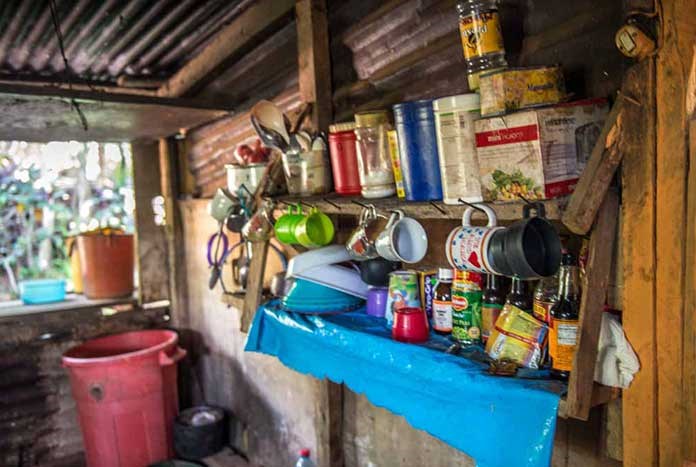
DIY: A make-shift kitchen built from recycled materials at Cepana Farm
— — — — — — — —
This struck me again on my next visit in 2004. My friends Andrew and Rosie Sheldon had been volunteering for CEPAD, and I came out to join them for a couple of weeks travelling around. I then joined up with a small Amos group led by Amos founder Garth Hewitt and his wife Gill, along with Amos supporters Sue and Simon Plater and Wilf Whitty who were on a short visit.
One afternoon we visited two very different communities about an hour’s drive from Managua, one of which was a community CEPAD had worked with. When our van pulled up at the side of the road in the first community it was unclear what we were going to see. We met a handful of people who appeared to live on this strip of land by the road, and who told us about some of the difficulties they were facing and of the plans they had for the future.
I don’t remember the details because they left little impression on me. But the place we visited about ten minutes up the road really did. We were warmly welcomed by a group of people who were keen to show us their plot of land. They rushed us around their little piece of paradise which was a riot of mango, banana, and papaya trees. There were chickens and pigs and a seed store. These people had found security, engaged with their creativity and had discovered hope.
Visiting this place planted a seed in me, too. I wanted to understand what had happened in the second community that made them flourish so profoundly. I wanted to tell that story, and support CEPAD in doing more of that work.
La Concha
— — — — — — — —
At the time Amos supported the Avocado Tree School in La Concha, the town where we were given mandarins. Amos supporter Annabel Walker was volunteering there in 2004, and she told us that for people in the town there were only 3 realistic options to make a living.
Firstly, pick Mandarins (that flourished there) and get the 4am bus to Managua to sell them in the market. Secondly, work in the sweatshops that had recently arrived in Nicaragua. Thirdly, go abroad to Costa Rica or the US to find work. The economic situation in the town spoke of what was happening internationally at the time: Nicaraguans, like Nicaragua, had so little power to change their destiny.
The country then was being run by Violetta Chamorro, and had embraced crippling IMF policies, and had racked up huge international debts. I remember Gustavo talking about this at Greenbelt in the 1990s. After his talk I asked him what could be done about it, and he said, “they won’t listen to a poor Nicaraguan like me. That is why you have to talk to them.”
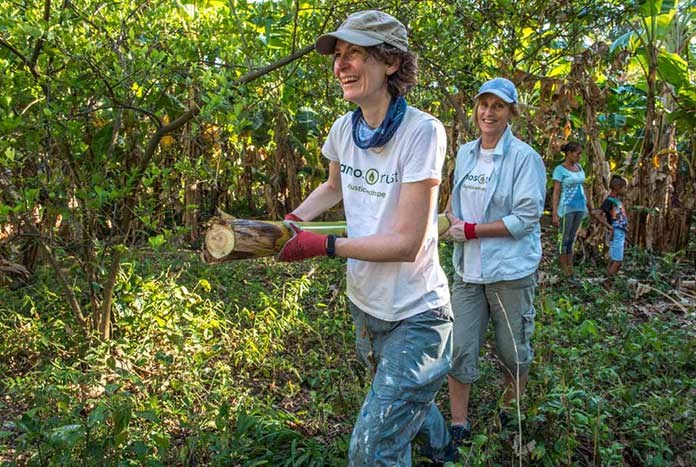
Working hard: Caroline Bone and Amos supporter Marion Saunders working in the community in Teustepe
— — — — — — — —
My wife Caroline and I had our own experience of the effect of those IMF policies when we stayed with a family in La Concha in 2007, as part of a 2-month long trip. Whoever was the first to get up would report back on whether there was any water that day. Some days the tap would run, some days it didn’t. This seemed to be one of the effects of privatising a previously entirely adequate water supply. Like the Nicaraguans, we just had to find ways to adapt to the new reality.
Another reality we adapted to feels familiar again as I write (in April 2021). For the few weeks we were in La Concha we barely spent any money, or did any of the things that people from the West usually do. We went to work, we came home, and hung out with our family. It was a life that felt radically simple, and it left a deep mark on us.
I distinctly remember how uncomfortable it initially felt to us uptight Westerners when we’d return home from work each day. Our family would rush to pull some chairs out of the house, and sit out in the street with us — even though our ability to communicate was limited. Simply being with people clearly mattered.
The highlight of our time in Nicaragua was our final week there. CEPAD has always hosted ‘delegations’ — groups, usually from the US, who come to volunteer at one of their rural projects. Our final week overlapped with a delegation from Southern California, led by stalwart Larry Hixon. He’d been bringing groups to Nicaragua for years, and they really knew what they were doing. Like we would say at Amos, they came to Nicaragua to learn, as well as work.
This year they’d be working in Matagalpa, starting work on the land that would become CEPAD’s ‘model farm’. They brought tools and gloves with them, aiming to leave them behind when they went home. And knowing they’d be somewhere rural without electricity they all brought the same book with them to study. So each night, after a hard day of breaking up concrete and shifting earth, a different person would lead a discussion on the next chapter of Jimmy Carter’s book. We look back on those days with great fondness. We’ve never worked so hard, slept so little, or laughed so much.
Where we learn
— — — — — — — —
After Caroline and I got back from that trip, Chris Rose asked if I’d consider becoming a trustee of Amos, with a particular interest in Nicaragua. At Amos there has always been a great fondness for the country, but it had been hard to articulate why we worked there, without saying, “you just have to go and see for yourself”. Even though I’d seen much of CEPAD’s work, I didn’t really understand how it all fitted together.
Over several years, visits and conversations, we came to understand the core model of their work. One of those conversations was with Gilberto Aguirre on a noisy Piccadilly Line train. He explained that CEPAD works in seven regions of the country. Six of those run from tiny regional offices. And each of those offices usually support seven communities.
They work with each community for 5 years, until they have the skills to walk on their own, or to quote Gustavo, “We walk with a community until it has the skills to claim the rights it did not know existed.” That’s their own model that they’ve perfected over nearly forty years. And that’s what I witnessed bearing fruit in that grove of mango, papaya and banana trees.
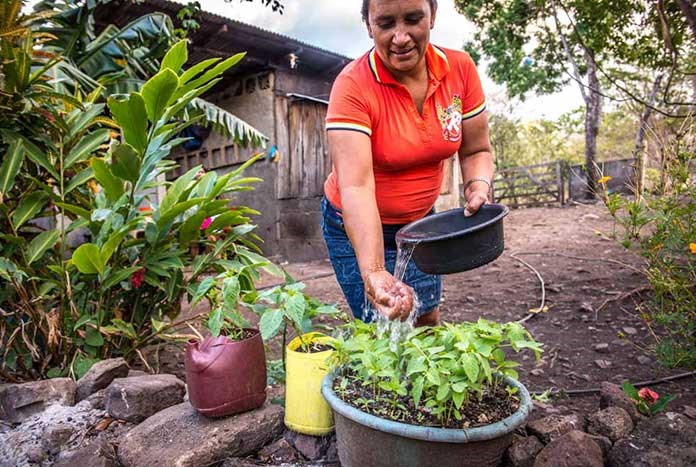
Water For Life: A women from El Pochotal in rural Nicaragua tends to her plants
— — — — — — — —
Another key moment in shaping our work in Nicaragua came about ten years ago. After a rollercoaster of a jeep ride we arrived in San Jose de Los Remates, where we met the staff from the Teustepe office for the first time. We heard about the new problems that the local farmers were having and that CEPAD hadn’t encountered before. They talked about a lack of rainfall, falling crop yields, and the urgent need to diversify the crops they were planting.
As ever, we were learning from the Nicaraguans. They were encountering climate change on the ground, and were pioneering simple, practical solutions that would make a difference to the communities they were working with. Amos supported their work in that community for five years. We then did it again by supporting the work of the Teustepe office in 7 other communities, which we are now starting to do for the second time.
In the past few years, it’s been my great pleasure to be part of two large groups that have visited Nicaragua. We have gone to see the inspiring work CEPAD is doing in these communities that are facing the effects of climate change.
We have eaten sumptuous home grown vegetables, grown by community leader Rosa, whilst sitting in her garden lit by newly-connected electricity. Previously, to feed her family, she had to buy food in the market in the nearest town a couple of times a week. She’d have to walk most of the way because the road wasn’t good enough for the bus to get near. Nowadays she goes by bus to the same market, on a new road, every few weeks to sell her surplus vegetables. This is what can happen when a community can claim its rights.
A highlight for myself and Caroline was to return to the place where we’d worked with the Californians — now called Cepana Farm. The “Solidarity Auditorium” now sits on top of the ground that we had dug up all those years ago. It’s where representatives from all of the communities CEPAD is working with come to learn sustainable farming techniques. They can also wander, as I did years ago, through lush plantations of mango, banana and papayas, and let it plant in them a seed of hope.
Peter Bone
— — — — — — — —
Peter Bone is a freelance graphic, web, motion designer and software trainer who has created numerous design books and online courses. Having travelled to Nicaragua with Amos Trust for the first time in 2000, Peter became an Amos trustee in 2007 until 2018 with a special interest in our work with CEPAD and in our work around climate justice.
More First Of The Month
Other editions of our First Of The Month essays are available to read and download from here.
Words of Hope E-news
Sign up to receive our regular ‘Words of Hope’ emails and keep up to date with all the latest Amos news and information, including details of our trips and events, news from our partners around the world, and all of our campaigns.
Online reflection
Join us for ‘Words of Hope’ online every Tuesday at 5pm — simply click here to join us a few minutes beforehand.
Amos Trust
7 Bell Yard, London
United Kingdom
WC2A 2JR
Telephone:
+44 (0) 203 725 3493
Email:
[email protected]
Registered Charity No.
1164234

This item has been added to your shopping basket. Please click on the Checkout button below where you can choose your quantity.
Continue shopping Checkout Close